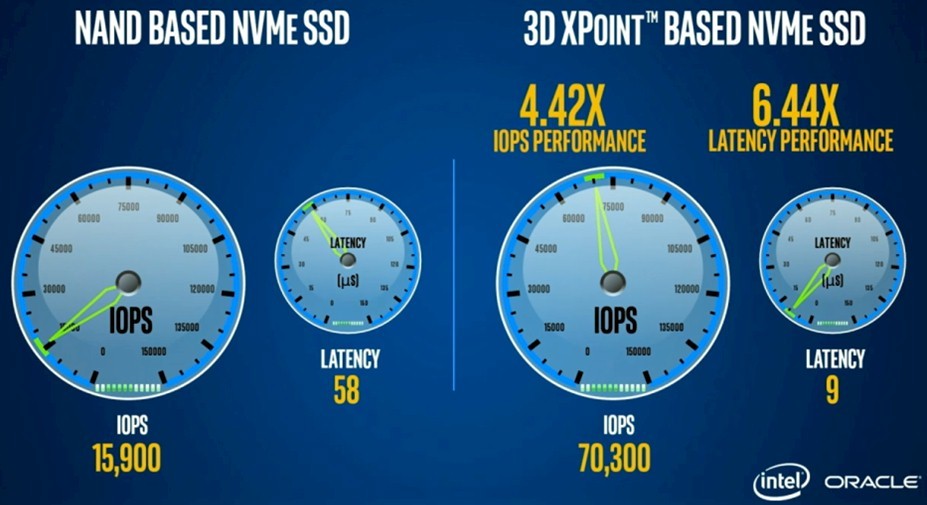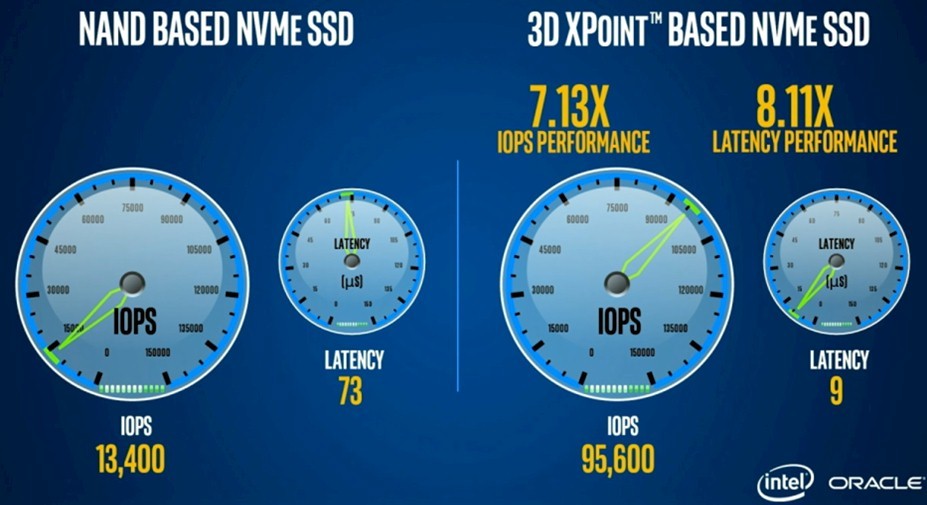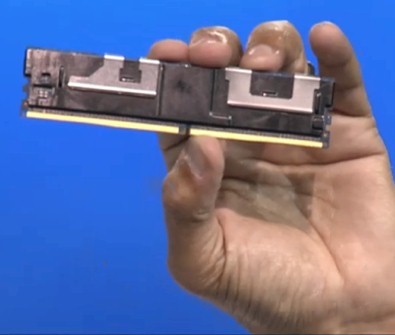Intel showed two more tests 3D XPoint
 On August 18, at the IDF 2015 forum, Intel for the first time demonstrated memory on 3D XPoint technology (crosspoint). Next year, drives using this type of memory will appear on the market under the Optane brand. It is reported that this is a fundamentally new type of memory that is different from flash memory solid state drives. 3D XPoint should be a thousand times faster than NAND and withstand a thousand times more write cycles. The new type of memory has an order of magnitude greater data density.
On August 18, at the IDF 2015 forum, Intel for the first time demonstrated memory on 3D XPoint technology (crosspoint). Next year, drives using this type of memory will appear on the market under the Optane brand. It is reported that this is a fundamentally new type of memory that is different from flash memory solid state drives. 3D XPoint should be a thousand times faster than NAND and withstand a thousand times more write cycles. The new type of memory has an order of magnitude greater data density. But Intel and Micron - the second company in collaboration with which the technology was created - hide both the principle of the new memory and the real performance gains.
At the moment, both companies are cautious about overall performance gains. It is also known that memory will be available in the form of DIMM strips and solid state drives. Optane's price will also follow this principle: it will be somewhere between flash memory and RAM modules.
In October, during an Oracle OpenWorld conference, Intel CEO Brian Krzhanich showed real-life memory prototypes and several tests from the scene. Optane is again compared to conventional solid state. Standard Promises of New Memory

In modern machines, performance is often limited by the speed of I / O to read-only memory. Therefore, the new technology is so important for high-performance systems, which especially feel the lack of balance between the speed of the processor and its RAM. To demonstrate the tests Krzhanich showed from the stage the machine on which the tests were conducted. The server looked at a standard single-unit Oracle X5-2 with two sockets for Xeon E5 v3 processors (Haswell). The server supports NVM Express technology. Two tests were launched on the server using the Red Hat Enterprise Linux Oracle clone. Each of the tests was run on an Optane solid-state processor and a traditional Intel P3700, the latter acting here as a “normal powder”. Specific test application names were not named.


The first test showed an advantage of 4.42 times the number of I / O operations per second and a delay of 6.44 times less. The second test spoke of an even stronger advantage: 7.13 times more speed, 8.11 times less delay. It would be very interesting to know what was specifically tested. The result shown is at about the same level that was demonstrated

at the IDF 2015 in August. Then Intel proudly showed off the stage the numbers 5.46 and 7.23 times the number of I / O operations per second. But this is still far below the beautiful statements about a thousandfold growth. Krzhanich promised that Optane will give about 200 times less variability. Probably, by this he meant that the delay in accessing data will be in a certain narrow interval and will not change much. Intel wants to ensure greater consistency in performance, said Krzhanich.
 3D XPoint is too fast to keep it far from the processor. Optane will be available both in the form of traditional solid-state drives, as well as RAM modules that do not lose data when disconnected. From the stage, Krzhachin showed a mechanical model of the future Optane memory module, which will be inserted into the DDR4 slot.
3D XPoint is too fast to keep it far from the processor. Optane will be available both in the form of traditional solid-state drives, as well as RAM modules that do not lose data when disconnected. From the stage, Krzhachin showed a mechanical model of the future Optane memory module, which will be inserted into the DDR4 slot.Apart from cache memory, Intel left the market for memory modules in 1985 due to great competition. It seems that next year a partial return will take place. Krzhanich promised working Optane memory modules for tests this year. Non-volatile memory will not be reset when power is lost, you probably have to get used to it. But disconnecting the server and stealing the data will fail, because they are encrypted. It is easy to assume that DIMM memory slats may require proprietary Intel logic, which precludes use in third-party solutions.
Intel continues to keep the veil of secrecy over the most important: on what principle is the work of 3D XPoint. All that is known is the use of a 3D structure to create cells with a phase state change for storing data. (It is very easy to find a patent called the “ X-point memory cell ,” which was filed in 2000.) Neither Intel nor Micron give specific expectations about the memory cell life. Intel categorically denies that 3D XPoint is a memristor.
Optane's scope is definitely not home computers. Intel has spoken about this before, and Oracle’s choice of event hints at focusing on servers for databases and other big data applications. Optane is scheduled for release in 2016.
